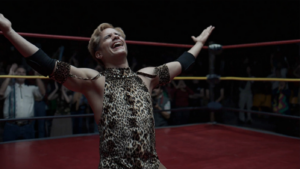In the 2018 Georgia gubernatorial race, former Georgia House of Representatives member Stacey Abrams could have become the first Black female governor in American history. While the election ended in Abrams accepting the victory of then-Georgia secretary of state Brian Kemp, Abrams went on to fight what she believes was the main cause of her defeat: modern voter suppression.
The 2020 documentary All In: The Fight for Democracy, directed by Liz Garbus and Lisa Cortés and starring Abrams, offers a provoking analysis of voter suppression throughout the United States, delving into its history, the evidence of its existence, and severe consequences of voter suppression in elections such as the 2018 Georgia race for governor. In order to maximize access to the public, the film was published for free on Amazon Prime for 24 hours on September 22.
Garbus and Cortés use their documentary to unearth the techniques that have created historic patterns of voter suppression, making facts accessible to those who need them most: young voters. The film includes interviews of scholars, lawmakers, and politicians in a compelling history of voter suppression going right back to the nation’s founding. Despite its heavy content, the editing is modern and energetic, with footage of political protests, interviews from the polls, and clips of televised news reports. All In is also accompanied by Grammy-nominated artist Janelle Monáe’s new song “Turntables,” featured in the film and released to the public on the same date as the documentary.
Four different constitutional Amendments, the 15th, 19th, 24th, and 26th, all promise that “the right of citizens of the United States to vote shall not be denied or abridged.” Yet as the documentary tells, even from the very beginning of U.S. history, the right to vote was never meant for all Americans. Originally, enfranchisement was only given to white male landowners—roughly 6 percent of the population of the newly founded United States—and this legacy of voter suppression has been alive and well from 1776 to 2020.
Undeterred by the constitutional amendments’ aims to expand voting rights to a larger electoral pool, state politicians implemented grandfather clauses that precluded much of the Black vote, literacy tests that a university professor might not pass, and economically-discriminatory poll taxes ensured that Black Americans were unheard in and disenfranchised from elections in the 1800s and 1900s. Today, the documentary reveals that voter suppression is accomplished through different tactics, such as the ones allegedly employed by Kemp in Abrams’s 2018 race, in a form of “Jim Crow 2.0.,” as termed by historian Carol Anderson.
As Georgia secretary of state, Kemp placed approximately 53,000 voter registrations on hold prior to his gubernatorial election, purged 1.4 million Georgians from the voter rolls, and closed or relocated over 50 percent of Georgia’s polling stations.
Activists and grassroots organizers featured in the documentary speak to the power that other voter suppression methods, including altered Voter ID laws, gerrymandering, and limited polling sites with six-hour lines, have on limiting the Black vote. In a roundtable interview, producers and directors Garbus and Cortés reacted to the extent of modern voter suppression they discovered in their research.
“We weren’t surprised, but I think of anything, we were always amazed at the reconfiguration of the tactics,” Cortés said. “It’s the literacy tests and how it becomes the poll closure, the purging—it’s how the tactics are merging through history.”
While All In primarily focuses on exposing the continued reality of voter suppression, it also celebrates the young men and women who have tirelessly fought for justice and made sacrifices to advance civil rights. The documentary’s use of archival footage and dynamic storytelling from different interviewees tears down the barriers between speaker and audience, making the film less of a history lecture and more personal.
Abrams herself became politically involved as a child, working with her friends on campaigns to get young adults to register to vote and organizing voter drives during her undergraduate years at Spelman College. The late Congressman John Lewis was only 25 years old when police attacked marchers crossing the Edmund Pettus Bridge in Selma, Alabama, with police clubs and tear gas on “Bloody Sunday.”
“I hope that college students will be inspired by looking at the film and the history, that great progress has been made and initiated by young people,” Garbus reflected.
Cortés explained that encouraging her children to care about the political process was one of her motivations behind the film. She recounted bringing her children to the polls to watch her vote in every election and, before then, pushing them around in strollers walking door to door to register neighbors to vote. Now, she gets to watch her teenage daughter and the rest of America’s youth organize, whether by volunteering in social media campaigns for political candidates or attending Black Lives Matter and climate change protests.
Cortés and Garbus hope that if young people take any lesson away from their film, it is the power of their vote. While college students often move around a lot and juggle academic and work responsibilities, the producers urge young people to utilize the resources provided by multiple organizations, such as the All In for Voting website, to register to vote or find out their registration status.
“Young people in America could have the most power, be the most influential voting bloc, if they showed up at the polls,” Garbus said, referring to an interview from the documentary. “Our government should be more reflective of our population in terms of age, in terms of race, in terms of gender, and when young folks show up, they have the power to make that so.”
Released just two months before the 2020 presidential election, All In could not be more timely for encouraging young people to send in their ballots by mail or go to the polls this November, especially as the current president obstructs access to people’s votes.
President Trump has attempted to delegitimize vote-by-mail ballots, claiming such voting methods will lead to corruption and electoral fraud. Cortés and Garbus refuse to let any incumbent politicians politicize mail-in voting in order to limit the voices of all the American people. During the roundtable, the producers argued that mail-in ballots were the best option to keep the public safe during the pandemic and that there is no evidence to suggest mailed ballots contribute to fraud.
While some Americans are disillusioned with U.S. politics, Cortés reemphasized why voting, even if a seemingly small act, can alter the history of the entire country.
“Of course not everything is going to change overnight,” she said, “but these are building blocks. Every election is a chance to expand the dialogue to include the needs of folks who haven’t been showing up at the polls.”
Cortés and Garbus’s documentary expresses everything that young voters need to hear, but it is a year too late. While the documentary’s theme of voter suppression is extremely relevant and tactically presented just before the U.S. presidential election, it would have been far more effective if released a year, rather than two months, before the 2020 election, giving viewers more time to register and prepare to vote using their newfound knowledge.
Two years after Abrams and Kemp’s gubernatorial election, articles and studies have been published about the extent of Kemp’s voter suppression tactics. The documentary does elevate attention over this specific incident, but attempts to elicit public backlash long after his misdeeds have already been exposed and, unfortunately, have blown over. And while voter suppression is always a vitally important issue to discuss, many Americans are somewhat demoralized in 2020 by the continued spread of COVID-19 cases, the death of Supreme Court Justice Ruth Bader Ginsburg, and the political fighting surrounding the impending election.
While the film might have received more attention in an earlier timeline, its message is undeniably powerful, and a compelling impetus for all voters to exercise their truly precious, and not always guaranteed, right to vote. All In: The Fight for Democracy is a documentary every American should watch because we need to be all in when it comes to voting, all in as voters of every eligible age group, racial background, gender, geographical location, and economic status. This November, your vote counts—so use it, keeping in mind the thousands of Americans who, both today and throughout history, have been and are being prevented from using theirs.






[…] Click here to view original web page at georgetownvoice.com […]
[…] Click here to view original web page at georgetownvoice.com […]